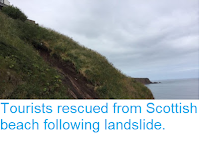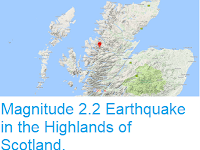Three climbers have died and a third injured following an avalanche on Ben Nevis, the tallest mountain in Scotland on Tuesday 12 March 2019. The incident happened at about 11.45 am GMT on a trail known as the Number Five Gully, sweeping four climbers from the Swiss Alpine Club in Valais, described as two Swiss and two French nationals, off the slope. One of the Swiss nationals, Mathieu Biselx, 30, is recovering in a hospital in Glasgow, with the other three dying on the mountain.
Four climbers caught in an Avalanche on Ben Nevis on Tuesday 12 March 2019. Mathieu Biselx/BBC.
Avalanches are caused by the mechanical failure of snowpacks;
essentially when the weight of the snow above a certain point exceeds
the carrying capacity of the snow at that point to support its weight.
This can happen for two reasons, because more snow falls upslope,
causing the weight to rise, or because snow begins to melt downslope,
causing the carrying capacity to fall. Avalanches may also be triggered
by other events, such as Earthquakes or rockfalls. Contrary to what is
often seen in films and on television, avalanches are not usually
triggered by loud noises. Because snow forms layers, with each layer
typically occurring due to a different snowfall, and having different
physical properties, multiple avalanches can occur at the same spot,
with the failure of a weaker layer losing to the loss of the snow above
it, but other layers below left in place - to potentially fail later.
Diagrammatic representation of an avalanche, showing how layering of snow contributes to these events. Expedition Earth.
The incident happened as Atlantic Storm Gareth swept across the UK, bringing high winds and precipitation across the country. Ocean
storms form due to heating of air over the sea in tropical zones. As
the air is heated the the air pressure drops and the air rises, causing
new air to rush in from outside the forming storm zone. If this zone is
sufficiently large, then it will be influenced by the Coriolis Effect,
which loosely speaking means the winds closer to the equator will be
faster than those further away, causing the storm to rotate, clockwise
in the northern hemisphere and anticlockwise in the southern hemisphere.
Whilst
the high winds associated these storms is extremely dangerous, the real
danger from such storms is often the flooding. Each millibar drop in
air pressure can lead to a 1 cm rise in sea level, and large storms can
be accompanied by storm surges several meters high. This tends to be
accompanied by high levels of rainfall, caused by water picked up by the
storm while still at sea, which can lead to flooding, swollen rivers
and landslides; which occur when waterlogged soils on hill slopes lose
their cohesion and slump downwards, over whatever happens to be in their
path.
See also...
Follow Sciency Thoughts on Facebook.








